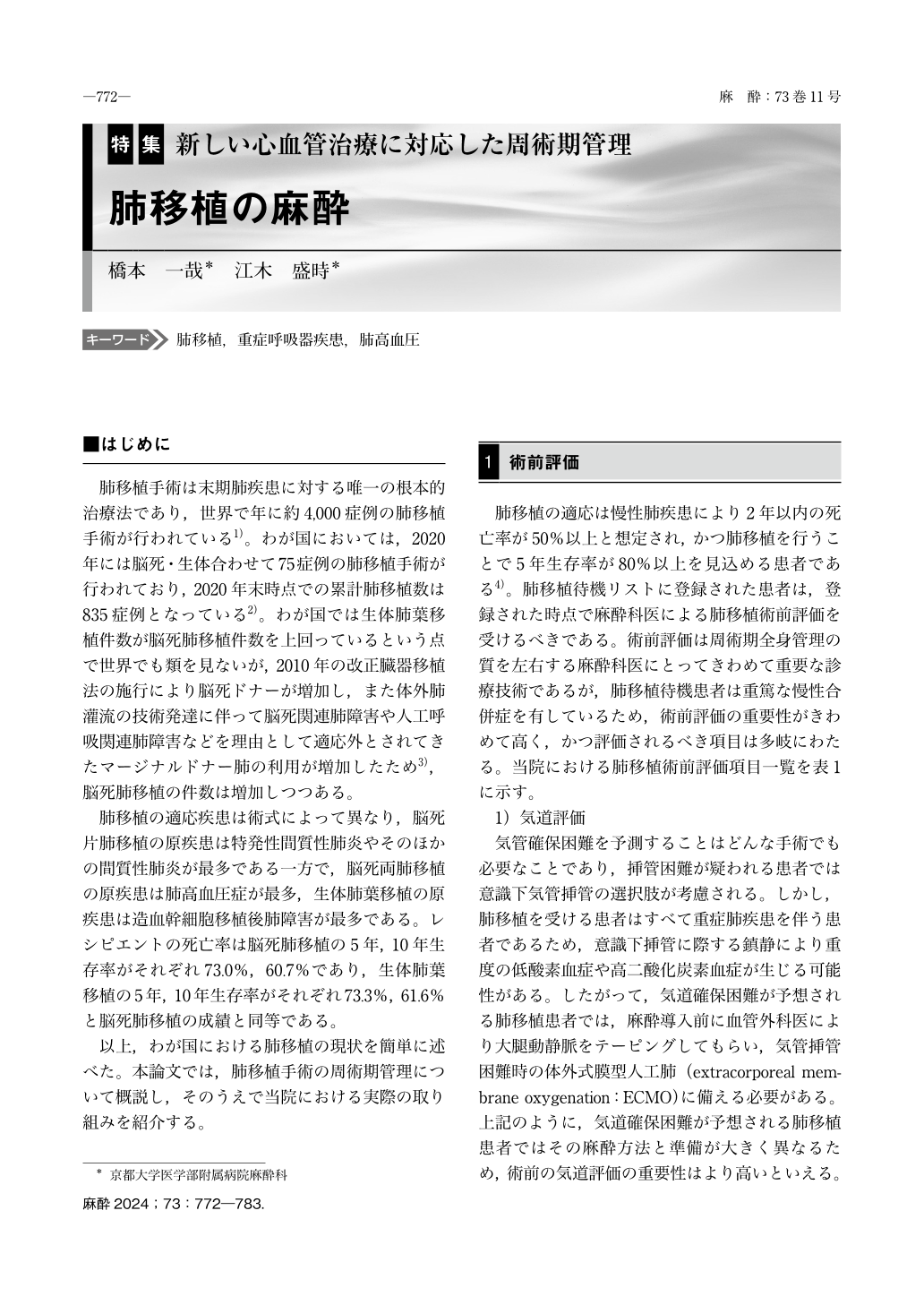Japanese
English
- 有料閲覧
- Abstract 文献概要
- 1ページ目 Look Inside
- 参考文献 Reference
はじめに
肺移植手術は末期肺疾患に対する唯一の根本的治療法であり,世界で年に約4,000症例の肺移植手術が行われている1)。わが国においては,2020年には脳死・生体合わせて75症例の肺移植手術が行われており,2020年末時点での累計肺移植数は835症例となっている2)。わが国では生体肺葉移植件数が脳死肺移植件数を上回っているという点で世界でも類を見ないが,2010年の改正臓器移植法の施行により脳死ドナーが増加し,また体外肺灌流の技術発達に伴って脳死関連肺障害や人工呼吸関連肺障害などを理由として適応外とされてきたマージナルドナー肺の利用が増加したため3),脳死肺移植の件数は増加しつつある。
肺移植の適応疾患は術式によって異なり,脳死片肺移植の原疾患は特発性間質性肺炎やそのほかの間質性肺炎が最多である一方で,脳死両肺移植の原疾患は肺高血圧症が最多,生体肺葉移植の原疾患は造血幹細胞移植後肺障害が最多である。レシピエントの死亡率は脳死肺移植の5年,10年生存率がそれぞれ73.0%,60.7%であり,生体肺葉移植の5年,10年生存率がそれぞれ73.3%,61.6%と脳死肺移植の成績と同等である。
以上,わが国における肺移植の現状を簡単に述べた。本論文では,肺移植手術の周術期管理について概説し,そのうえで当院における実際の取り組みを紹介する。
Lung transplantation is well-established as the last option for patients with end-stage pulmonary disease. In Japan, the number of living lung-transplant patients exceeds the number of brain-death lung transplants, and the outcomes are comparable between living and brain-death lung transplant cases. A variety of diseases are candidates for lung transplantation, including pulmonary hypertension and interstitial lung disease, and anesthesiologists need to understand the characteristics of each disease in order to perform the appropriate perioperative management. In particular, patients with severe pulmonary hypertension are at high risk of circulatory failure and cardiac arrest due to the induction of anesthesia, and extracorporeal membrane oxygenation must be available before the anesthesia induction in these patients. In intraoperative patient management, fluid infusion and ventilation strategies are important to prevent primary graft dysfunction and improve long-term prognoses. The monitoring of patients’ extracorporeal circulation and transesophageal echocardiography(TEE)monitoring are additional important factors in efforts to improve postoperative outcomes. The postoperative management of lung transplantation patients requires attention to adequate analgesia, complications associated with vascular and bronchial anastomosis, the possibility of primary graft failure, and right heart failure in addition to the routine intensive care. This article reviews the preoperative evaluation, intraoperative management, and postoperative management of patients undergoing lung transplantation, with a particular emphasis on intraoperative extracorporeal circulation and transesophageal echocardiography.

Copyright © 2024 KOKUSEIDO CO., LTD. All Rights Reserved.


